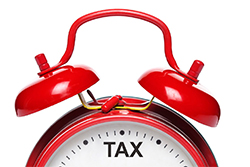Don’t let ADHD Get in the Way of Tax Time

It’s one month until this year’s tax deadline. Are you ready?
For many people affected by ADHD, managing the tax deadline and the challenges presented by ADHD symptoms can make this a crunch time. Difficulties with organization can mean that important papers are not in one place or easily gathered. Executive function challenges with time management and sensing the flow of time can make this looming deadline seem further away than it is.
If you haven’t filed your taxes already, here are some steps to get you started:
1. Make your plan and write it down. This can be in the form of a checklist or “to-do” dates on your calendar. Some online calendar systems will allow you to email reminders to yourself. Making a plan can address the tendency towards procrastination that often comes with adult ADHD.
In your plan, schedule an appointment with a tax professional or a day on your calendar to prepare your taxes. There are very good online tax preparation programs you can purchase for low cost – several of these can be downloaded. Also, some large chain stores make it easier to find a tax professional by having them available during tax season.
If you want to work with a tax professional but cannot afford to hire a company or an individual professional, check your community for a free tax service. Often available through community or senior centers, local libraries or local community colleges, these programs provide certified tax preparers to assist you for low or no cost. The IRS has a listing of tax professionals.
2. Collect everything you need to file your taxes in one place. Even a shoe box will help in compiling records for you and your family members – such as bills, interest statements, and mortgage taxes. It doesn’t need to be neatly filed or sorted. Just having the pieces together will help when preparing your taxes.
In your collection of information, you should have your proof of health insurance coverage and any related statements from your health insurance company, which may be Forms 1095-A, 1095-B, or 1095-C. When completing your taxes, you will need to provide information on health insurance coverage for yourself and family members as part of the Affordable Care Act requirements.
3. Complete your taxes on your chosen day. When the day comes to meet with a tax professional, bring your box or file of information, along with any personal identification and checking account information you may need. The tax professional will assist you with appropriate questions and guidance. Ask the professional to e-file for you while you are in the office. If you think you might owe taxes and need to send a paper check, bring a pre-stamped envelope with you to the tax preparer’s office. The tax preparer can place the return in the mail for you.
If you are doing your own tax filing, set up your work area with your computer, personal information and box or file of tax information first, so everything is in one place before you begin. Consider using an online tax preparation program. This will walk you through each step of the process and gives you the opportunity to go backward for corrections.
If you use an online program for your taxes, you will be offered two choices to send your completed taxes to the IRS. The first will be to print a hard copy of your tax form, attach copies of your W-2 and other related documents, and send them by postal mail. The other option is to e-file by sending the completed taxes electronically through the online tax preparation program.
Many people find it’s easier to e-file their completed tax form. Doing so means taxes are done and you don’t need to go through the process of printing the form and placing it in the postal mail, either in a local mail box, giving it to the mail carrier, or taking it to the post office. E-filing simplifies the last step of doing your taxes.
4. Keep a record of this year’s tax return. Be sure to have a copy of your taxes printed by the tax professional or print your own copy at home. Set up a storage system — add it to your box of information or put all the papers and the copy into a file folder. Label the box or file folder and store this in your home filing system, or a safe place where you keep your family records.
Some people with ADHD have found themselves in the situation of not having filed their taxes recently due to their disorganization and procrastination. This is not uncommon, but since it can lead to more serious problems, you should meet with a tax professional who can offer guidance to resolve the situation. It is helpful to remember that they are ready to help you and have the expertise to do so.
Still looking for more information? The IRS has free Tax Tips and Resources to help.
